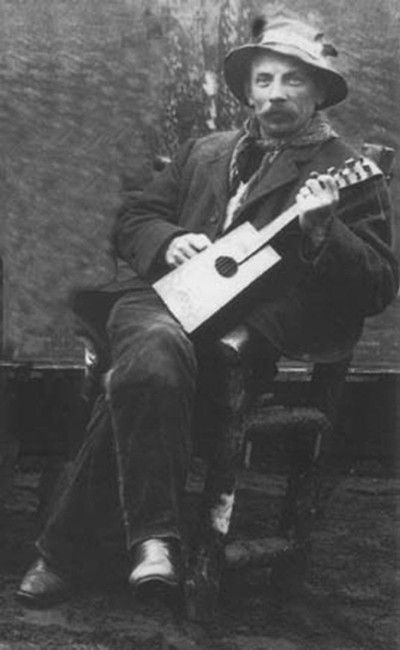
Editor’s note: This is a guest post from Luke Brown.
Learning a brief history of the cigar box guitar should give you some serious inspiration to build one of your own. The cigar box guitar was originally a homemade instrument for individuals who couldn’t afford to buy an actual instrument. The trend took off in small African-American communities in the late 1800s and later during the Great Depression because of widespread poverty.
If you lived in that time period without money and you wanted to play an instrument, you needed easy-to-find tools and supplies, along with a talent for resourcefulness and ingenuity. The necks were usually made from broom handles and most only had one string. In fact, there was a saying that playing a cigar box guitar only hurt once. When mom was gone, the kids would take apart her broom and stick the handle through a cigar box. They would then take the wire that held the bristles on and stretch it over the broom handle until they could produce a sound. When mom got home, she would give the kids a good whipping, but had no way of putting her broom back together…so the kids played, and it only hurt once.
The first time I saw a cigar box guitar, I knew I had to build one. I hadn’t done much woodworking yet, but it looked like something I could tackle. I discovered that they are quite simple and can be built with some basic household tools. As a bonus, the cost is very low and the possibilities are endless; no two cigar box guitars are the same. When you really get creative, your guitar can say a lot about your personality. Make it yours.
Most of the tools to make your guitar are common in homes. If you don’t have them, check with your family, friends, or neighbors. Any tools or lumber you need can be found at most hardware stores. For the guitar components, the best place I’ve found to get them is online at C.B. Gitty Crafter Supply (www.cbgitty.com). A cigar box can be found at most tobacco shops that sell cigars for, at most, $5.
Click here to see the Parts List.
In no way are you restricted to the parts list I’ve provided. There are many different options available for tuners, strings, etc. The measurements I’ve provided below are for the parts I’ve listed. If you do choose other parts, your measurements might be different. Use a ruler or caliper to measure each part so that it will fit correctly.
Terminology
To get familiar with cigar box guitars, the first thing to do is learn the terminology.

The Neck
The first thing to build is the neck of the guitar. Although “neck†refers to the middle part of the guitar, our neck will extend all the way through the cigar box, so it will be longer for now. The neck needs to be a hardwood or it will slowly bend over time with the tension of the strings. A few good recommendations are in the parts list above. The board dimensions should be 1″ X 2″ X 36″. After you buy the board, you’ll notice that the board’s actual measurements are 3/4″ X 1 1/2″ X 36″. This difference will not have an effect on the measurements below. Use your coping saw to cut the neck to length if it isn’t 36″ long.


Looking at the design of the wood, decide which end you would like to be the head and write “head†on the end of the neck. The next thing to do is cut a notch out of the end of the head where the tuners will go. Mark 4 1/2″ in from the end of the neck and 1/4″ in from the fret side (you’re marking 1/4″ on the 1″ side of the board).
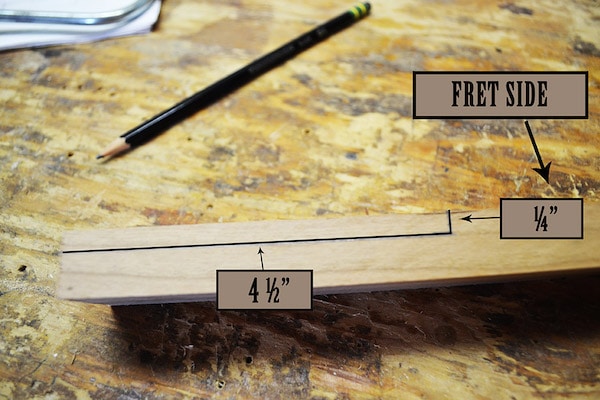
Now, it’s time to cut out the head-piece. Use your coping saw to cut the piece out. When you’re done, use a file and sandpaper to get it nice and smooth. When I build these guitars, I like to leave them a little rough around the edges to show some character.
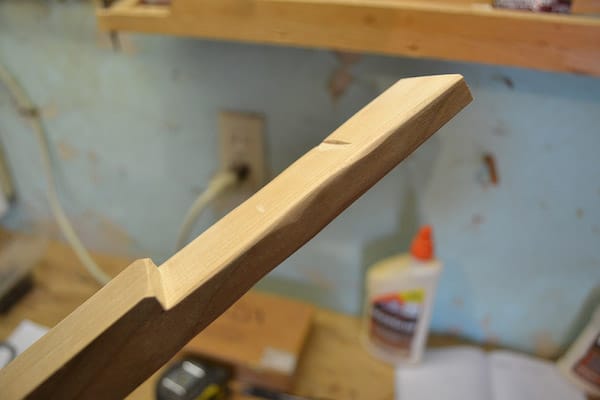
The dent is from my dog — I left it in rather than start over.
The Body (Cigar Box)
It’s time to put the neck down and pick up the cigar box. The way you cut the cigar box will depend on what type of box you have. Most paper-covered boxes have a lid that lays down inside the edges of the box. A lot of non-paper cigar boxes have a thicker lid that lays down on top of the sides rather than inside it. No matter the cigar box, the next step is to mark the place where the neck will go through. Measure the width of the cigar box and mark the center.
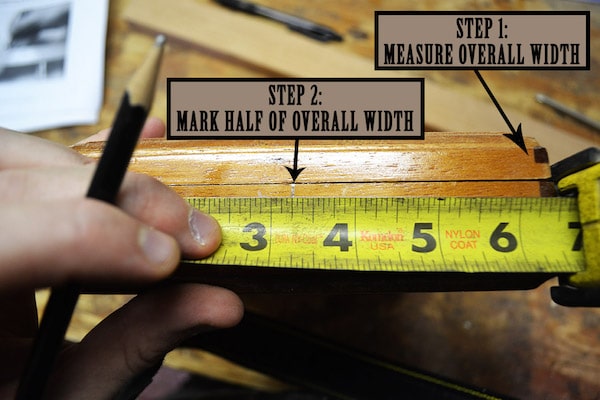
Now, measure the width of the neck. If the neck is 1 1/2″ wide, measure out 3/4″ (half) to each side of your mark and make another mark. This will keep the neck centered and tight in the cigar box.

Using a coping saw is pretty straightforward. You can direct the path of the saw by rotating the handle and the direction of the blade. You can also adjust the blade within the coping saw itself by holding onto the c-shape and turning the handle counterclockwise. This will loosen the tension and allow you to turn the wing on each end of the blade.
If you have a wood box: Use your coping saw to cut the lid through the lines you’ve made until you hit the point where the face of the box meets the sides of the lid. (You will see a line where the face of the box is glued to the sides.) When you’re done, there should be a smooth flat surface from end to end where the neck will lay. Do NOT cut into the bottom section yet.
If you have a paper box: If your neck is 3/4″ deep, measure 3/4″ from the top of the box and draw a line between the two lines you marked previously. Use your coping saw to cut the section out. Leave the lid alone for now.
Note: It is better to cut the hole too small rather than too big. You can always use your flat file to enlarge the hole later. If the hole is cut too big, the neck will rattle and shake inside the box. Also, cigar boxes are fragile — work slowly and carefully.
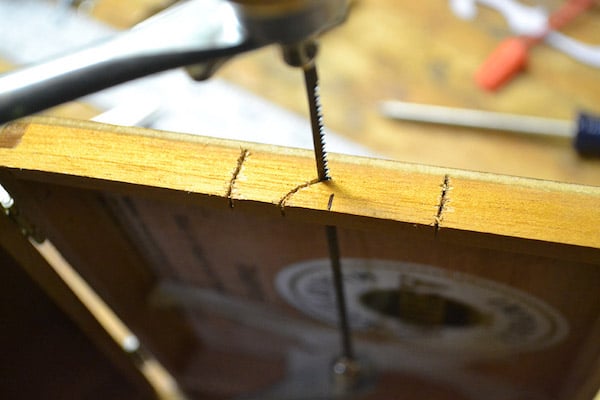
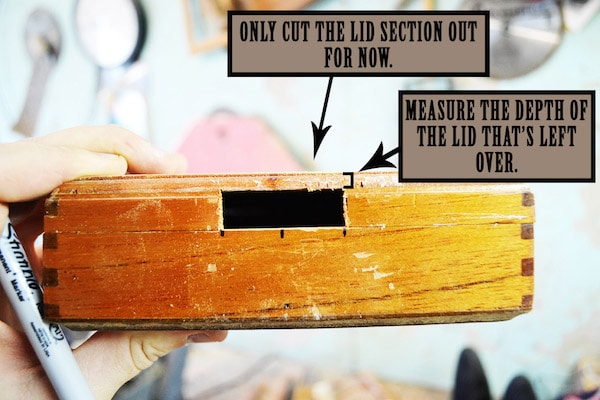
Make this cut on both ends of the box.
Fitting the Neck to the Body
When you’re done, make sure the neck fits tightly in the notches you cut out. Now, measure the depth of the lid that’s left over and the length of the cigar box. (Note: if you’re using a paper box, simply measure the depth of the lid). Take your neck and measure 4″ from the tail end. Make a mark on the fret side of your neck. Starting at the four-inch mark, measure up the neck the length of the measurement of the cigar box that you just took and make another mark. Turn the neck on its side and measure down from the marks you just made. This measurement will be the depth of the lid. Make these marks on both sides of the neck and connect them with a ruler.
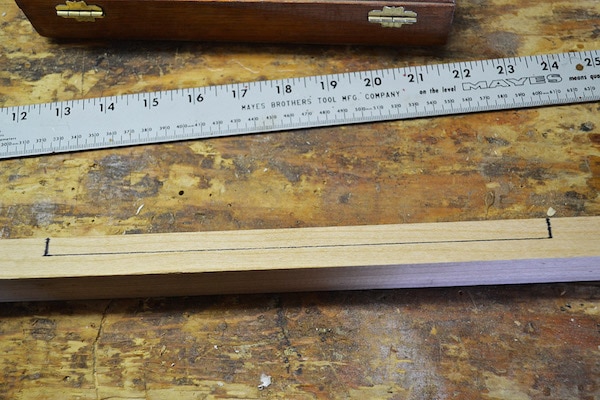
The next thing to do is use the coping saw to cut out the section you just marked. Use the flat file and sandpaper to get things as smooth and flat as you can. When this is done, fit the neck into the cigar box and make sure that the neck and cigar box are flat across the top. If you’re using a wood box, you have one more step: measure how much of the neck is still keeping the box from closing. Using the marks you made earlier, use the coping saw or file to cut out more of the box so that you can close the lid snugly.
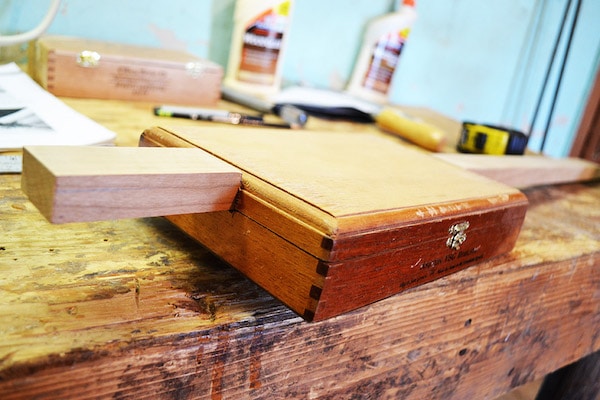
Making It a Guitar
Get out your door hinge. This is going to be the tailpiece of the guitar that holds the strings in place. Mark three spots and drill them with a 1/16″ bit. Do this on top of an old junk board so that the drill bit can go through without hurting anything.
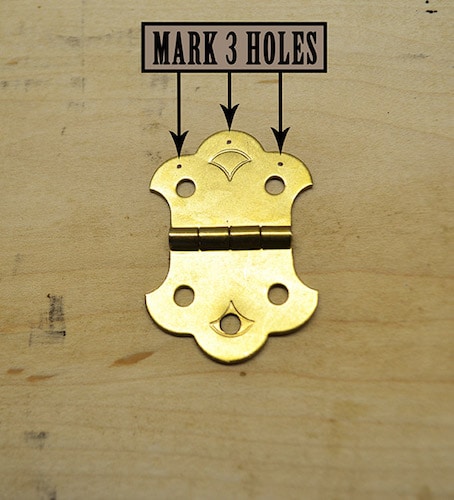
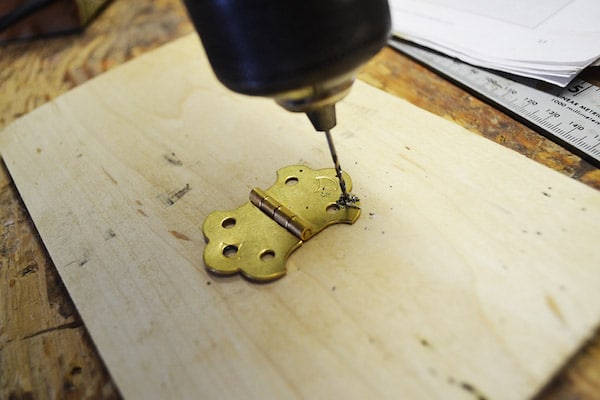
Once you have the holes drilled, lay the hinge on the tail of the guitar. The end you drilled the holes in will be pointing towards the head of the guitar. With the end that you didn’t drill the holes in, lay it flat on the end of the neck and make sure it is centered. Mark two holes and pre-drill holes for the screws that will hold it in place. (Don’t actually attach it yet, just do the drilling.)
Pre-drilling ensures that the screws are accurate and easier to put in. All the holes in this project must be pre-drilled. Some of the screws are very small and the heads of the screws might break off if you don’t pre-drill. When doing this, it helps to determine how deep you want the hole to go. If you want to drill down 1/4″, measure 1/4″ up from the point of the drill bit and wrap some masking tape around it. That way, you can drill down until you hit the tape and then quit. Remember to always use a drill bit that is slightly smaller than the screw.
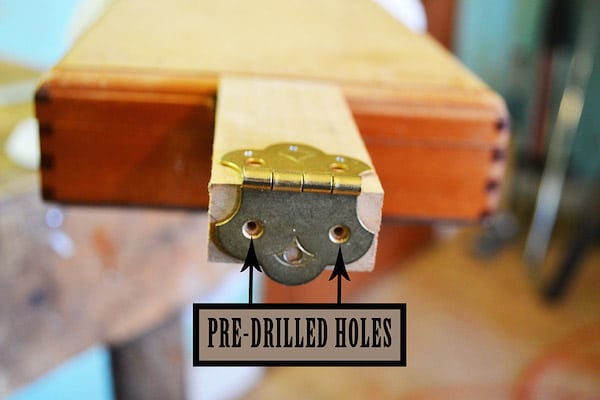
With that done, it’s time to drill holes for the tuners in the head of the guitar. Whenever you are drilling, always mark the center of the hole. The measurements below give the center of the tuner holes. Mark the holes on the fret side of the head. Important: if you have a pack of 3 tuners, you’ll need to determine if you have two right-handed tuners or two left-handed tuners. Left-handed tuners are those on the left side of the head as you look at the upright guitar from the front and vice versa for the right-handed. The photo below is of the back of the head, but the tuner is left-handed. The diagram below is for two right-handed tuners and one left-handed tuner.

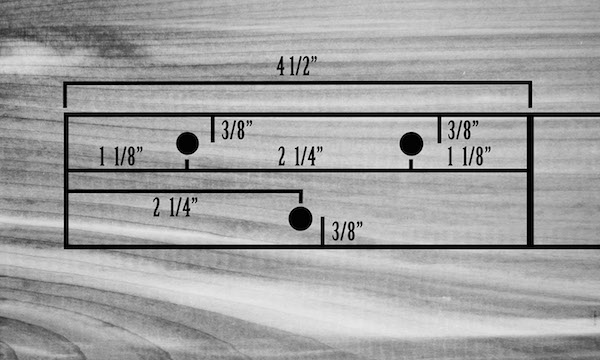

This next part is a little tricky. You’ll need two drill bits: 1/4″ and 5/16″. On the side facing you (picture above) you’ll need to drill down the depth of the tuner bushings (diagram below). Mine are 3/8″, so I marked the drill bit with masking tape at 3/8″ and drilled until I hit the tape with the 5/16″ bit. When you have those drilled, take your 1/4″ drill bit and drill the rest of the way through the head. When you hold the tuner in from the bottom and put the tuner bushing in the top, it should look something like this:
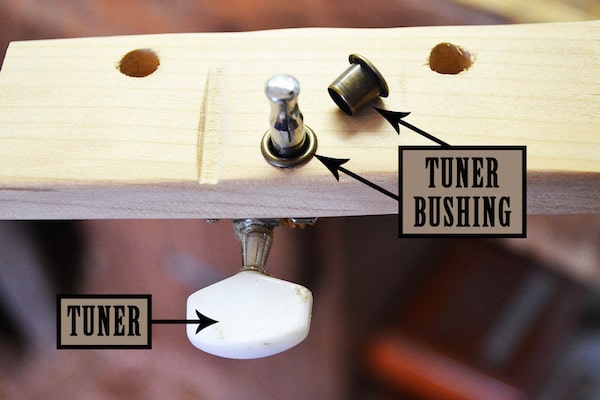

Time for the nut and bridge. If you didn’t get them on the website provided, you can buy a 1/4″ or 5/16″ bolt from any hardware store and cut the head off with a hacksaw.
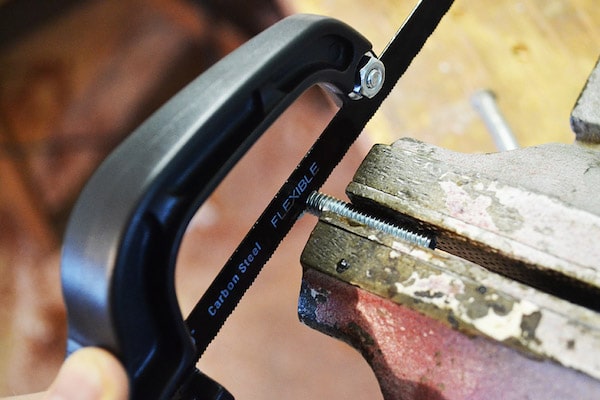
On the edge of your neck board where the neck meets the head, make a mark 1/4″ away from the head. Use your round file to etch a groove where the nut will sit. It works well to make the groove half the diameter of the nut.
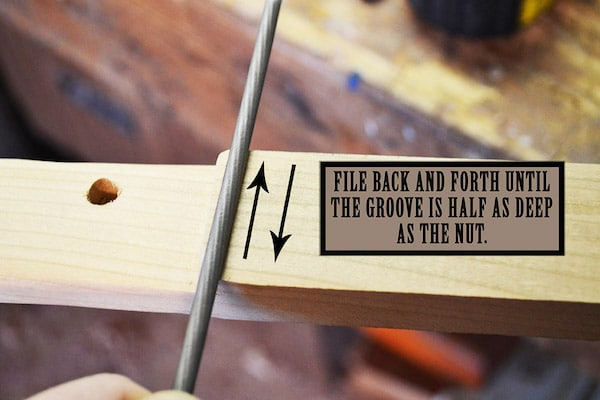

The bridge will simply sit in the small groove where the tail of the guitar meets the cigar box. Depending on how the neck fits into the box, you can find a bigger bolt/bridge to get the strings at the height you want. The purpose of the nut and bridge is to give the strings distance from the neck and to give you a “scale length.†Scale length is the distance from the center of the bridge to the center of the nut. Once you have found the scale length, you’ll need to use a fret calculator to determine the distance between the frets. I use this website to find the fret distances. In the first slot, you can put as many frets in as you want. I just enter 24 and then decide how many I want as I go up the neck. It depends on how high you might want to play. I never play above 15, so that’s usually as far as I go. On the scale length, enter the measurement you took from the bridge to the nut. Try to be as accurate as possible. Choose your unit of measurement and “acoustic guitar.†It should give you something like this:

Once you have your fret scale, use your caliper to mark fret to fret (starting from the nut). You’ll need to be very accurate here. If you measure the first fret wrong, all of the frets will be wrong. If you want to mark the common blues scale frets, mark a circle between frets 2-3, 4-5, 6-7, 8-9, and 11-12 (double circle). (Note: in the picture below, my first fret was 1.543″. The fret scale above is just an example.)
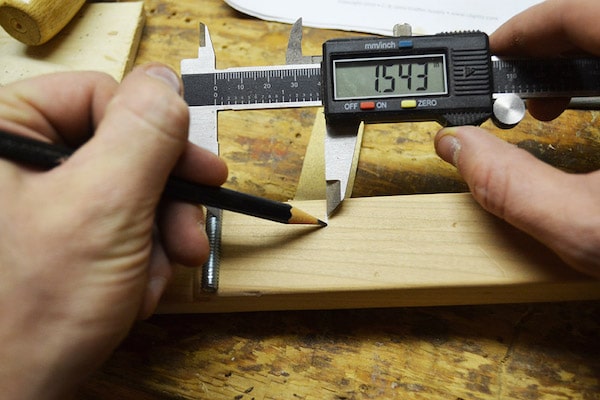
Once you have all of the frets marked, you’ll need to mark them permanently. The easiest way is to purchase a wood-burner and burn them in that way. When I didn’t have a wood burner, I used a gas stove and a nail held by pliers to burn them in. Carefully hold the nail over the flame with the pliers until it’s hot and then burn the wood along the line you made.
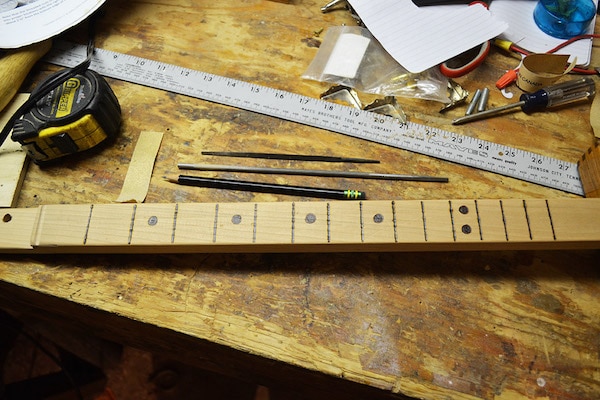
It’s time to cut sound holes in the cigar box. This is a place where you can be really creative. You can make a hole in any shape or form that you want. For mine, I decided to use f-holes. You can either sketch your sound hole on the box free hand or you can sketch it on a piece of paper and cut it out. Since I was making two holes, I traced it so that they would be identical. Once you have the marks on the box, drill a hole in the box where the hole is going to be. Now, unscrew the handle of your coping saw and remove the blade. You can now pull the saw back and forth through the lid to cut out your design. If you have gloves, wear them…this can be hard on your fingers.
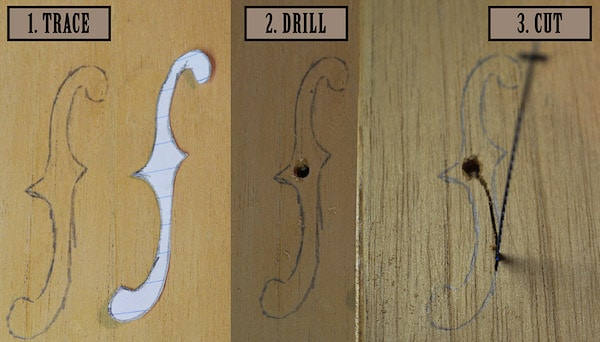
Once you have them cut, use your flat and round files to get them looking sharp.
Personalizing Your Cigar Box Guitar
Here is where you really make this guitar yours. You can sketch something you like on the guitar or find an image that you like and use a photo editing program to make it black and white. Print out a few different sizes of the image. Cut them out and try them in different places on your guitar. The back of the guitar provides a large canvas or you can use any open space on the front. For mine, I decided to use the Art of Manliness logo and put it in the top right corner of the front side. Wherever you decide to put it, you’ll have to sand the finish off of the wood. Trace the image onto the wood and do your best to fill in the shaded areas.

Use your wood burner or heated nail technique to burn the dark parts of the image. If you mess up, you can always sand it off for touch-ups.
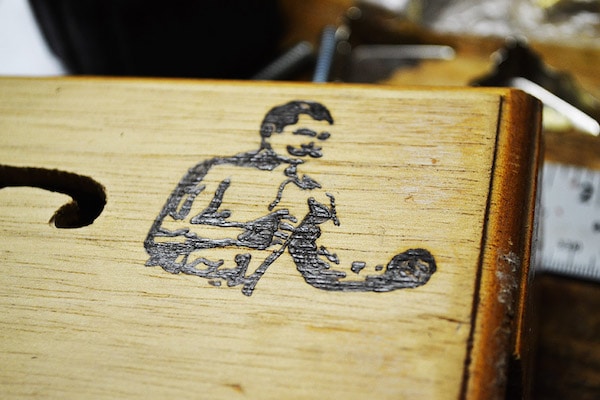
If you want to leave the wood raw and unfinished, you can start assembling the guitar right now (skip ahead to the next section). However, if you want to stain or varnish the guitar, now’s the time to do it. If you want to stain it, you can do that now or sand off some rough edges. To get it smooth, start with a lower grit (rougher) sandpaper, like 100-grit, and move up through 320-grit. Remember to sand with the grain of the wood and not against it (“with the grit†means to sand with the lines in the wood rather than against). I like to get the neck edges rounded so that I can play it smoothly and not have to worry about getting cut. The easiest way to do this is by cutting a strip of sandpaper about an inch wide and pulling it back and forth over the sharp edges.
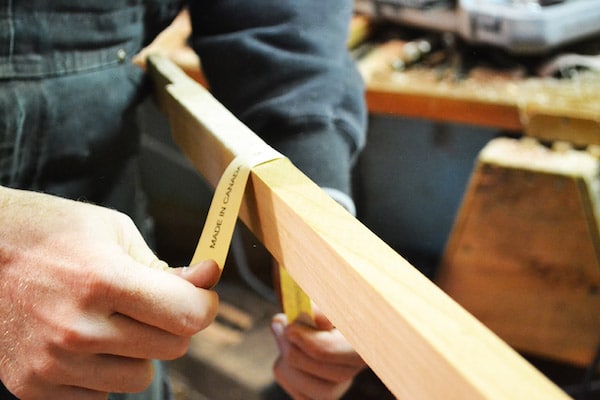
Keeping with the rustic feel of the cigar box guitar, I sometimes make marks in the wood that make it look a little beat up. This can be done with a knife, screwdriver, or hammer. If you stain it, the stain will be darker in any marks that you make.
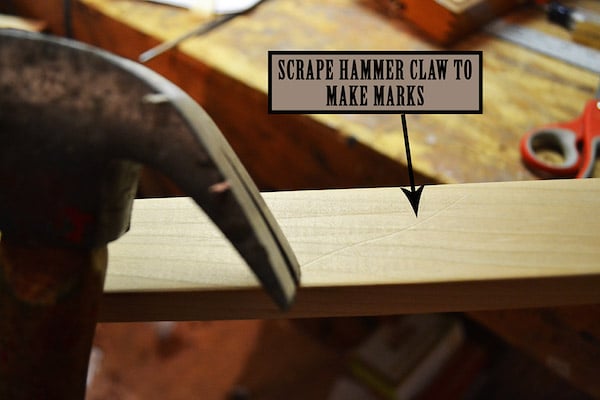
The stain that I’ve found to work best is oil-based. Find a stain color that you like and an old rag. You can stain the parts different colors too; I stained the box one color and the neck another. You’ll have to take out the tuners, screws, and tailpiece. Shake up the stain can for about a minute and remove the lid. Wear latex gloves to protect your hands from the stain and harmful chemicals. Dip your old rag into the stain and rub the stain into the wood. If you want it darker, you can reapply the stain after 30 minutes. When you’re happy with the color, set the neck and box out to dry overnight.
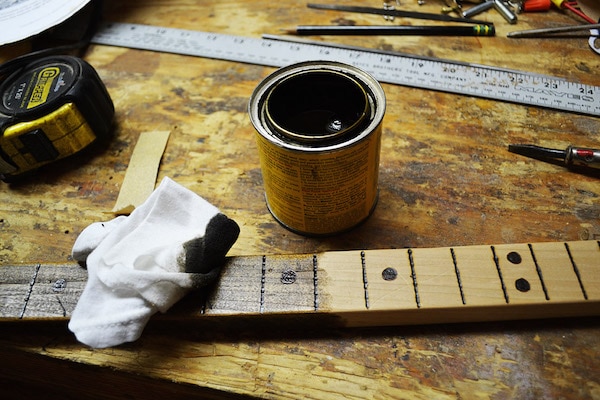

The easiest way to finish the cigar box guitar is to use a can of aerosol lacquer. You can use either glossy or satin. Glossy will appear shiny and thick while satin will be more subtle. Shake the can for a full minute and then hold the it 12″ away from the wood. Lay the wood on some plastic or newspaper so that you don’t get lacquer all over your tools and workspace. Hold the nozzle down and spray back and forth, releasing the nozzle at the end of each sweep. Don’t spray too much or it will run. It’s better to spray on too little rather than too much, as you can always put on more coats later. When one side has dried, flip the project over and spray the other side. It’s best to do this inside a garage so that bugs and dust don’t get stuck in the lacquer. When the lacquer is no longer sticky, you’re ready to assemble your guitar.
Assembling the Guitar
Place the neck back into the cigar box and install the tuners, tailpiece, nut, and bridge. Take out your set of strings and run them through the holes of the tailpiece. The largest string goes on top and the smallest on the bottom. Run the strings over the bridge and nut. When you get the string to the tuner, make as many wraps as you can starting from the bottom. When there’s an inch or two left, run the remaining string through the hole in the tuner and pull it tight. Turn the tuner until there’s some tension on the string. You can then move it around on the ridges of the bridge and nut so that they are evenly spaced.
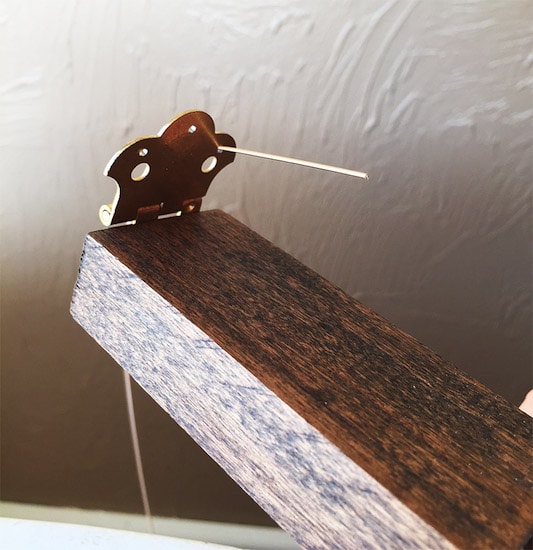
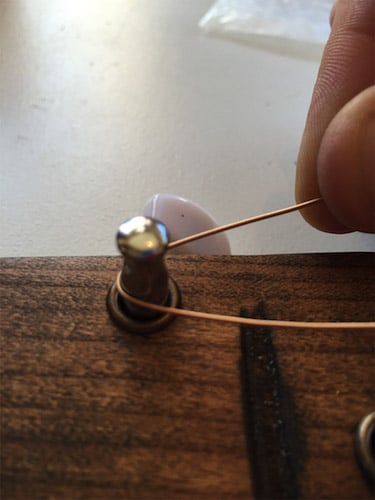
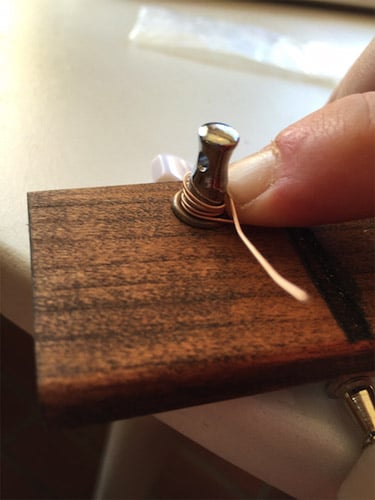
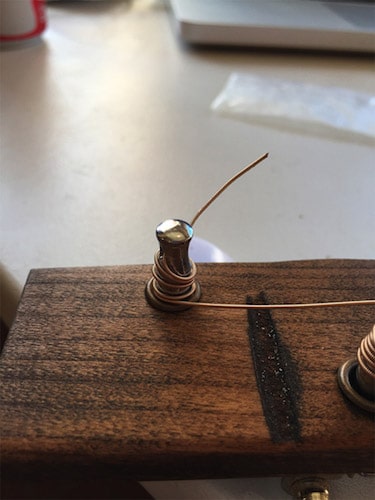
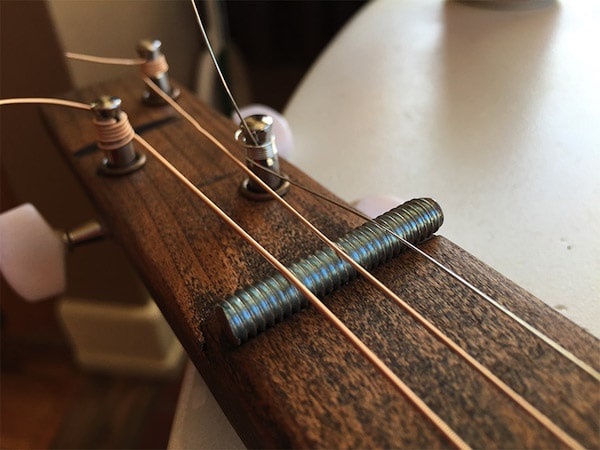
You can tune the strings by searching for an online tuner, buying a chromatic tuner, or installing a tuning app on your phone. The way you tune your guitar depends on what strings you bought. I bought low open G strings, so mine are tuned to G-D-G. As the strings pull everything together, they will go out of tune very easily. The first time you tune a guitar, it usually takes 4 or 5 tries to get it to stay.
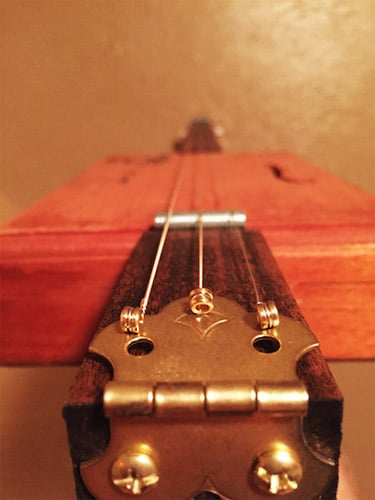
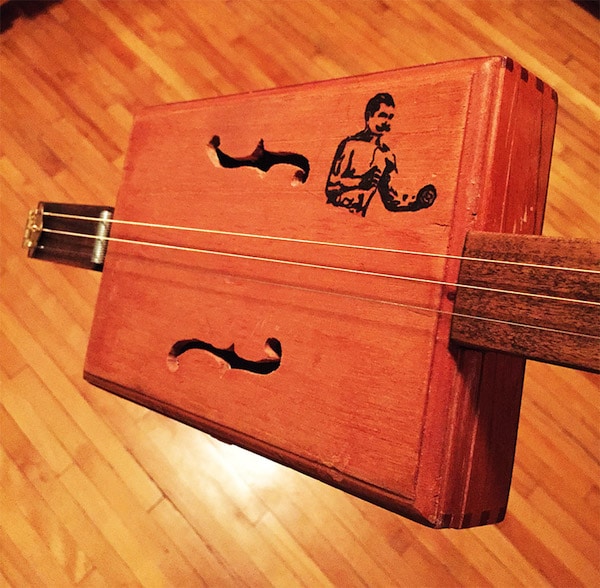
One final step: get yourself a guitar pick and a slide. You can buy a slide or you can make one by breaking off the top of a glass bottle or cutting off a piece of copper pipe that fits your finger. Most slides are 3 or 4 inches long.
Learning how to play can be discouraging at first but, with practice, you’ll get good at it. There are plenty of how-to videos on YouTube that you can learn from. They will teach you songs, theory, and style. One who provides great lessons and tutorials is a man named Mike Snowden. His YouTube channel can be found here.
In the short tutorial I’ve provided, there are 4 important frets. They are the 3rd, 5th, 7th, and 12th. These are the main frets of the blues scale and experimenting with them will teach you many songs. A free metronome on a website or app on your smartphone will help you keep rhythm. It might sound stiff at first (like in the video below), but once you get it down, it will sound much more natural. When you’ve gotten good enough, you can stomp your foot or improvise in the songs to make them your own.
Now that you’ve got the hang of building a guitar, your next one will be even better. Look at different guitars on the internet, pick out things you like, and put them on your next one. If you look hard enough, you’ll find cigar box ukuleles, banjos, and even violins. You can make your guitar electric, make different head designs, add steel frets, and even put more strings on it.
Get to it, and if you make one, come back here and leave a comment with a picture of it.
__________________________
Luke Brown is a rancher & self-taught carpenter in Western South Dakota. Using his experience as a carpenter, Luke founded the Cedar Horse Workshop with his passion to spread and teach the skills of craftsmanship.


